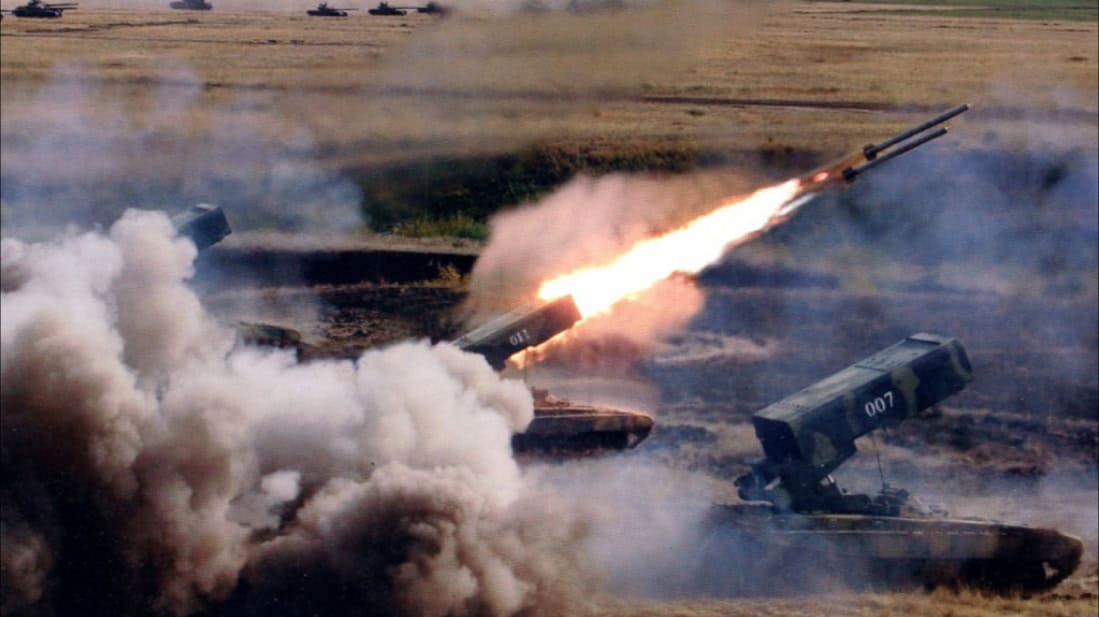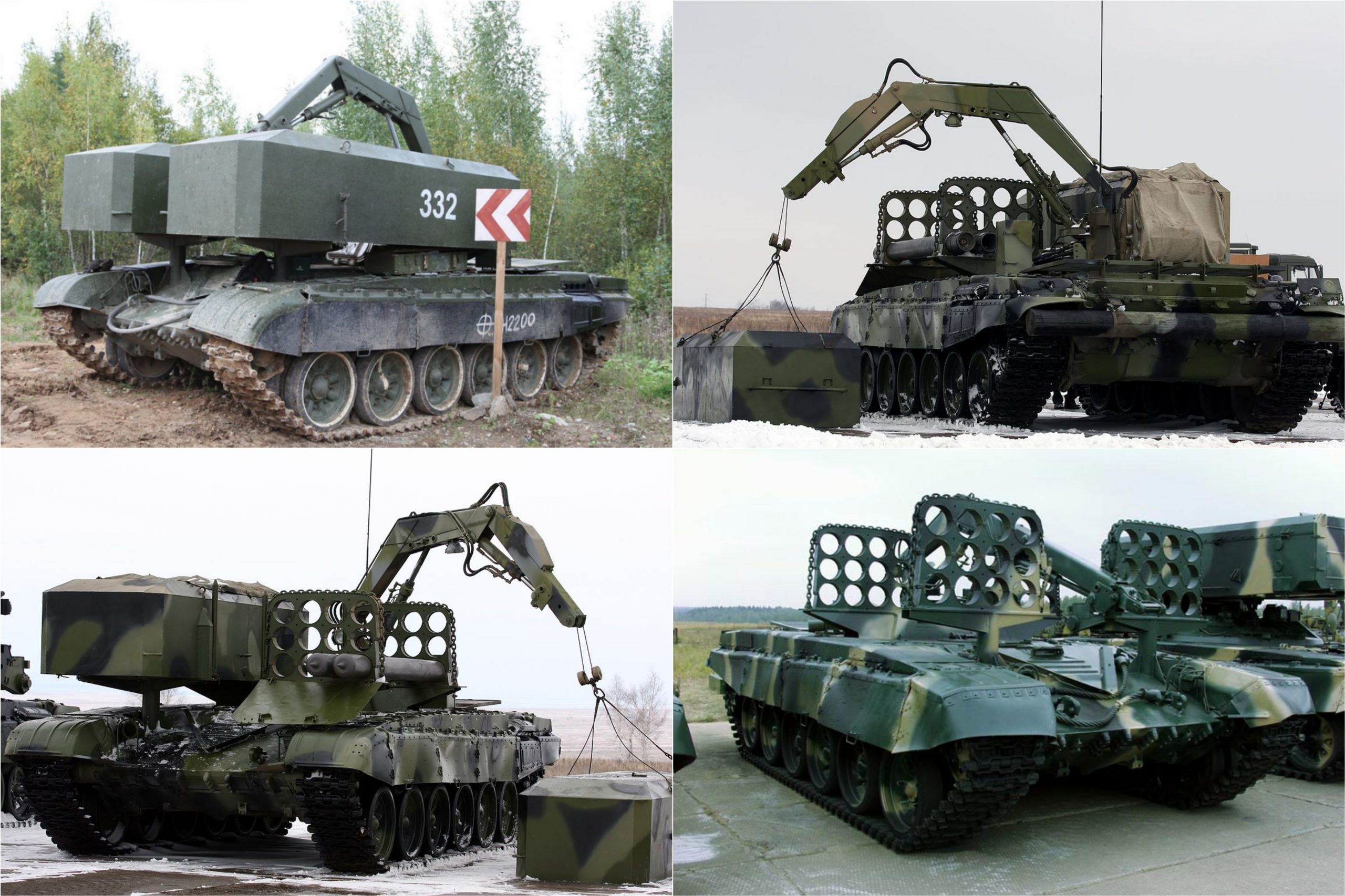
Since the beginning of the large-scale invasion in February 2022, the Russian invasion forces have been actively using TOS-1A ‘Solntsepyok’ heavy flamethrowers at the front line.
The invaders are using these weapons to shell the positions of the Defense Forces and Ukrainian settlements to destroy them and break through the Ukrainian defense.
In their turn, Ukrainian military servicemen destroy these enemy weapons by various means. They have also repeatedly captured such systems along with their transport and reloading vehicles.
So what is this Russian ‘Solntsepyok’ and what danger does it pose to Ukrainian defenders? Today we will reveal the details of these deadly flamethrower systems.
The history of this family of weapons began with the TOS-1 ‘Buratino’ heavy flamethrower, which was designed to destroy vehicles, set fire to and destroy buildings, and destroy manpower located in open areas or fortifications. For this purpose, unguided rockets equipped with a thermobaric warhead are primarily used in the salvo. The main factors of their action are high temperature and rapid pressure change.

Ammunition with an incendiary warhead can also be used. A full salvo can be fired in 12 seconds for single launches and 6 seconds for paired launches. The time to prepare the system for use after the vehicle stops is 90 seconds.
Work on the system in the USSR continued in the 1970s. It was entrusted to the Omsk Transmash Design Bureau. After successful completion of state tests, which began in 1980, the system was put into service. TOS-1 was first used in Afghanistan in 1988–1989 and later in Chechnya.

The TOS-1 ‘Buratino’ system consists of a launcher based on a T-72 tank and a heavy flamethrower transporter-loader on the chassis of a KrAZ-255B truck.

This machine is designed to transport unguided rocket projectiles and load them onto the launcher.
A 30-tube launcher for 220mm unguided rockets is mounted on a rotating platform, protected by lightweight armor capable of withstanding hits from 7.62mm bullets. The decision to use tank chassis allowed the ‘Buratino’ to operate within combat formations and closer to the front lines, providing a necessary level of armor protection. This design choice was essential, as the system’s short range—2.7 to 3.6 kilometers, depending on the type of rocket—required closer proximity to the target.

The crew consists of three servicemen: a driver, an operator, and a commander. The system is operated entirely from within, allowing the crew to remain inside the vehicle.

Guidance is carried out using a fire control system that includes a pitch sensor, optical sight, laser rangefinder, and a ballistic computer that calculates the required angle of elevation of the launcher. Manual control of the launcher is also provided.

Each unguided rocket for the TOS-1 weighs 175 kilograms. The weight of the thermobaric warhead is 74 kg, and the incendiary munition is 45 kg.
In 2001, the Russian army adopted the TOS-1A ‘Solntsepyok’ heavy flame thrower, which was designed to improve the combat performance of its predecessor. Its main difference was a smaller number of launching tubes: 24 instead of 30. The system received shells with an extended range of up to 6 kilometers. It also uses the tracked chassis of the T-72 tank.
In addition, the system includes the TZM-T heavy flamethrower transporter-loader, which is also based on the T-72 tank, not a truck like its predecessor.


The crew of the TZM-T consists of three people, and the ammunition loading time is 24 minutes. During transportation, the ammunition on the vehicle is protected by additional removable armor.

For TOS-1A, the projectiles are 3300 mm to 3700 mm long and weigh 173 to 217 kilograms. In total, the system consists of one launcher and two transport and loading vehicles.

In the Russian army, the TOS-1 is not part of artillery or mechanized units of the ground forces, but rather serves with the Russian NBC Protection Troops (Radiological, Chemical, and Biological Defense). The ‘Solntsepyok’ was specifically chosen by the Russian invasion forces and has been actively used against Ukraine since February 2022.
In the war against Ukraine, the Russians also use the TOS-2 ‘Tosochka’ wheeled system, which is based on the Ural-63706 truck with a 6×6 wheel configuration, unlike the TOS-1 and TOS-1A, which are built on a tracked chassis. The TOS-2 launcher has fewer tubes than its predecessors, with only 18 available.

The launcher’s cab has been armored to shield the crew from small arms fire. And the use of a wheeled chassis increases the efficiency, mobility and range of the vehicle. This Russian flamethrower system received a set of navigation equipment that allows it to fire from unprepared positions. The use of an automated fire control system has increased the accuracy of the attack.

The TOS-2 ‘Tosochka’ was also equipped with a mechanized ammunition loading unit, which allows the crew to load rockets without the use of a special vehicle. This enables the crew to reload the launcher itself after the salvo.

The developers claim that the system can use modernized projectiles that allow it to fire at a greater distance than the TOS-1A missiles, which have a range of 6 kilometers.
In February 2024, Militarnyi reported that Russia was working on a new heavy flamethrower system, TOS-3, called ‘Dragon’. This system is being designed based on the existing TOS-1 and TOS-2 systems, which the Russians are actively employing in the war against Ukraine.

Judging by the images that were published online at the time, the new TOS-3 will be based on a tank-tracked chassis, like its predecessors ‘Buratino’ and ‘Solntsepyok’, with the launcher borrowed from the TOS-2 ‘Tosochka’. According to the image, each ‘Dragon’ self-propelled launcher will be capable of launching 15 unguided rockets with an incendiary or thermobaric warhead.
The main type of ammunition used by the ‘Buratino’, ‘Solntsepyok’, and ‘Tosochka’ launchers is mostly thermobaric rockets.
In the massive use of thermobaric projectiles, destruction is achieved by the high temperature of the shock wave and overpressure.

The 220mm caliber unguided rockets consist of a thermobaric or incendiary warhead, a fuze, and a solid rocket motor.
The front part of the thermobaric projectile has a thin, pointed detonator fairing designed to create a volumetric explosion. This design allows the munition to avoid immediate detonation upon impact. Instead, it first disperses a cloud of a special combustible mixture around it. This mixture can “flow” into shelters or maneuver around obstacles before being ignited.

Thermobaric munitions, such as oxidizer, use atmospheric oxygen, so they are much more powerful than conventional munitions. When a thermobaric munition is detonated, the shock wave travels along the ground, making it impossible to hide from it in a trench or dugout. And the temperature at the epicenter of the explosion reaches 3,000°C.
The Russians are actively using TOS-1A ‘Solntsepyok’ and, to a lesser extent, ‘Tosochka’ against the Ukrainian Defense Forces. However, for example, TOS-1As have to approach very close to the front line because the maximum range of their missiles is only 6 kilometers.

Since 2022, Ukrainian defenders have repeatedly destroyed and captured these flamethrower systems and their TZM-T heavy flamethrower transporter-loaders. Recently, these are usually FPV kamikaze drones or UAVs with munitions that operate behind the invaders’ lines near the front line both day and night.
The Ukrainian Defense Forces also used a trophy TOS-1A ‘Solntsepyok’ against Russian positions while they still had ammunition, which was also captured from the invaders.
However, we should not underestimate the power of these enemy weapons, which they use to hit Ukrainian fortifications with infantry and settlements where the Defense Forces are stationed. Therefore, such heavy rocket launchers must be destroyed by all available means to save the lives of Ukrainian defenders.
Підтримати нас можна через:
Приват: 5169 3351 0164 7408 PayPal - [email protected] Стати нашим патроном за лінком ⬇
Subscribe to our newsletter
or on ours Telegram
Thank you!!
You are subscribed to our newsletter